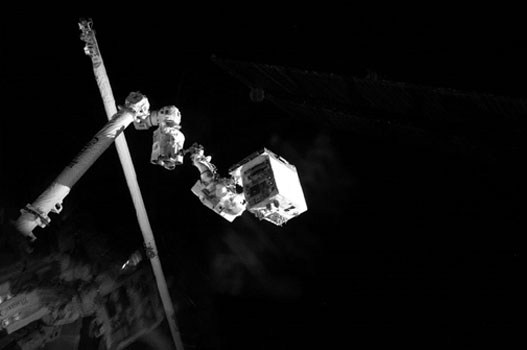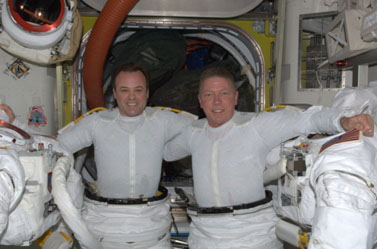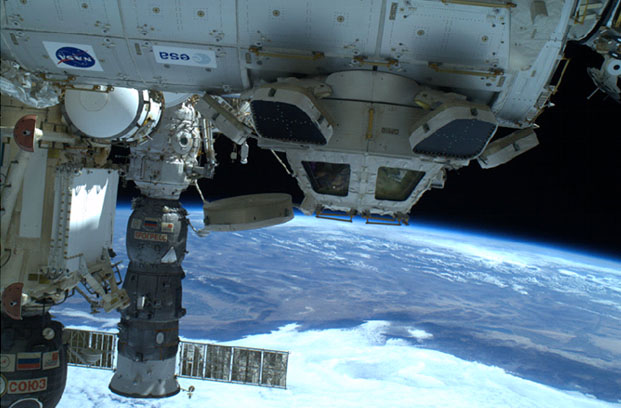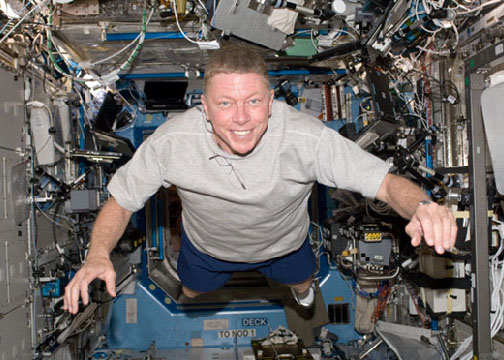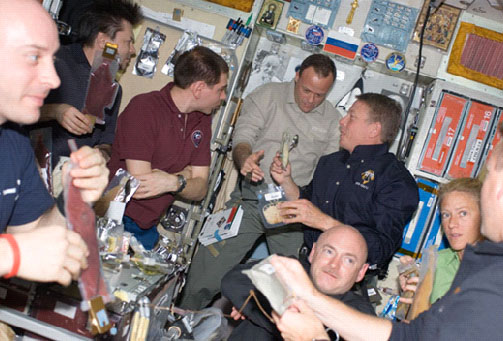July 9, 2011
Atlantis is on the way! With weatherthreatening to delay the mission and an interruption in the countdown at 31seconds (!) before launch, the crew of STS-135 has begun their voyage!!

Ron Garan and Iduring suit fit check a couple of weeks ago. Aftertraining underwater for over 250 hours together and doing 3 spacewalks onSTS-124 three years ago, we definitely have a feeling of “Getting the band backtogether”!

Collecting samples from a freezer,which stops all biological activity at a crisp -98OF. This spaceshuttle flight will be our last opportunity to get a lot of these valuableresearch samples home for a while.
The period of time leading up to thishistoric event has been unbelievably busy on the International Space Station.We arrived exactly one month ago on June 9th. We’ve been busypreparing the ISS, preparing for our spacewalk while they are here, andcollecting scientific and engineering samples to go home on the last spaceshuttle.
As busy as each day can be, all workstopped yesterday as we watched the launch of Atlantis with a live video feedfrom Mission Control in Houston. The major event overshadowing all of our workfor the last month has been preparation for this mission, so it was appropriatewe joined the rest of the world in viewing this historical event.

There are a wide range of emotions whichrun through you watching any human space launch. Those haven’t changed muchsince I watched as a child: Excitement, fear, anticipation, wonder, and hopefor the future. We hold our collective breath as the beast roars to life.Cleared the tower – check. Good roll program – check. Go for throttle up –check. Solid rocket booster separation – check. Go for nominal main engineshutdown/go for pitch maneuver – check.The cadence of a highly-trained crew onboard Atlantis and on the ground is likemusic to our ears. There are challenges and much work ahead, but for now, allis well.
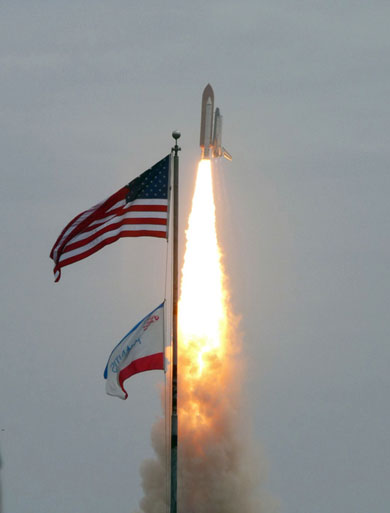
Thisis the only photo we have onboard the International Space Station ofyesterday’s launch of Atlantis to begin STS-135. Since you’re reading this, you have at leasta passing interest in our nation’s space program and have probably seen dozens,if not hundreds, of photos of this historic event. I don’t need another one. After 30 years ofspace shuttle missions, this one says it all for me.
Make no mistake, the preparation andlaunching of any spacecraft is a tough business for tough people. This is truefrom the top managers who have to make the tough decisions to the technicianson the ground who hone their rocket maintenance skills on the weekends keepingtheir Harleys in perfect running condition. They prepare that spacecraft foreach mission with the same tender loving care they use to polish the chrome toa perfect shine for a Sunday ride. For us astronauts, that’s not “our” spaceshuttle. The technicians who care for them daily make it very clear theyconsider each to be “their” space shuttle. The ground team just allows us takeeach vehicle out for a ride and we better bring them home in good shape! Youhave to really trust someone to loan them your bike. Same goes for spaceships!
The spaceshuttle launch image is one which symbolizes America. It is powerful, huge,tough, bold, and at times audacious. Today the famous launch pads at KennedySpace Center have gone silent. We’ll have more time to ponder the implicationslater. For now, we have a mission to execute.
Come on up,Atlantis! We’ll leave the lights on for you and have a cup of coffee waiting!!
Living theDream!
-Mike Fossum


